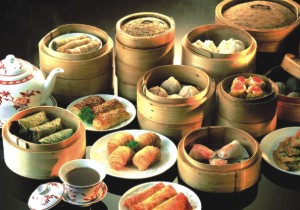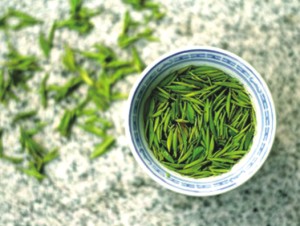|
Lifestyle
The Taste of Real China
Sheema Hossain
 Curiously enough my first taste of Chinese food while in China on vacation happened three tedious days after my arrival. It's the Bangali traveller's curse which comes from the blessing of the community. I knew a lot of Bangladeshis in Hong Kong and they spared no expense on my comfort and sightseeing. However, when it came to eating out, suddenly they seemed to be devoting themselves only to McDonalds and KFC while steering clear of any restaurant boasting Chinese delicacies. The truth was inevitable. We have an innate distrust for foreign food and added to that is our firm belief that original Chinese food constitutes stewed frogs and crisp fried insects. It was out of sheer luck that in Shenzhen we met two Bangladeshis who had been living in China for quite some time. They offered to show us around for the day and after that the frogs and insects took a backseat as we made our way through the bustling city of shopping malls, bazaars and, of course, Chinese restaurants. Curiously enough my first taste of Chinese food while in China on vacation happened three tedious days after my arrival. It's the Bangali traveller's curse which comes from the blessing of the community. I knew a lot of Bangladeshis in Hong Kong and they spared no expense on my comfort and sightseeing. However, when it came to eating out, suddenly they seemed to be devoting themselves only to McDonalds and KFC while steering clear of any restaurant boasting Chinese delicacies. The truth was inevitable. We have an innate distrust for foreign food and added to that is our firm belief that original Chinese food constitutes stewed frogs and crisp fried insects. It was out of sheer luck that in Shenzhen we met two Bangladeshis who had been living in China for quite some time. They offered to show us around for the day and after that the frogs and insects took a backseat as we made our way through the bustling city of shopping malls, bazaars and, of course, Chinese restaurants.
It is safe to say that the Chinese food available in our country, though fabulous in its own way, is poles apart from the original thing. Generous heaps of tasting salt makes not a Chinese cuisine. Original Chinese food to the Bangladeshi palate may seem too bland or too adventurous. This is quite amusing considering the fact that Bangladeshi cuisine does have a lot in common with that of China- a love for rice, spices and pickles. It is the difference in approach to food which brings about the disparity. In Bangladesh a flavourful dish is attained through marinating it in a blend of innumerable spices and herbs. It is what makes our kitchens so aromatic and curries so rich. In China, however, it is the individuality of every spice and ingredient, which is given more importance. Thus you will come across many dishes where only a few herbs or spices have been used, that too sparingly, so that the senses are not confused and the flavour remains true to the ingredients. It must be kept in mind, however, that this is a gross generalisation since
Chinese cuisine is different in different parts of China.
This was quite true for the incredible lunch I had in Shenzhen. I particularly remember the chicken for the main course. It was roasted and shredded, served with peanut oil. It was a simple roasted chicken like any other, sans the spices, herbs or gravy. And yet, just by adding that peanut oil the complete taste of the dish was transformed. The same principle applied to the rest of the meal. Fried rice with scrambled egg whites, broccoli in oyster sauce, deep fried whole prawns, steamed whole fish with sautéed fresh vegetables, and of course the essentials: beef chili and Peking duck. All of these enjoyed between generous servings of Chinese tea. However, the dim sum and curry-puffs were the items that really stole the show for us. The dumplings were delicately shaped into rabbits resting in a bamboo steamer while the curry puffs were molded into swans. The minute attention to detail and striking presentation reminded us of one of the basic principles of this famous cuisine- the importance of the aesthetic appeal of food.
 |
Green Tea |
Dinner was more a gastronomic experience than just a regular meal. I once had Hot Pot in Thailand but that was quite bland compared to the one in China. It began with us taking one of the tables with stoves in the middle. As we munched away on the starters, which were grilled lamb ribs (by far the best I have had) and herby pita bread, a waiter expertly lighted the stove and put on a pot full of water so spiced with chillies, it was red. Another waitress ceremoniously handed our host a list written in Chinese. Here having someone who knows Chinese really helps because that is the language on the menu and no one speaks English. It was a list of raw ingredients to boil in your soup. All you have to do is tick the ones you want. What we ordered- rolls of raw beef, lamb, fish balls, spinach, potatoes and coriander- were pretty boring compared to the assortments we could see in the surrounding tables. Some I thought I recognised. For example, there was a white rubbery spiral tube which looked distinctly like the intestines of an animal. The others were just too foreign to me.
On the train back to Hong Kong I nearly collapsed from what felt like molten lava being poured into my insides. The whole trip I cringed with heartburn - too much red chilli in the Hot Pot. Next to me I could hear my relatives dreading the inevitable weight-gain that would result from the day's gourmet excursion. Yes, food in China is heavenly indeed. Only you realise it doesn't make you invincible to worldly ailments.
Chinese Eating Etiquette:
* They view eating with hands as something alien. So if you can't learn to use chopsticks you better ask for forks and knives. Even things like Grilled Lamb Ribs are served with disposable gloves!
* At any Hot Pot restaurant, prior to eating, the waiter will leave a kettle of hot water on the table so that you can clean your soup bowl to make sure its safe. It's a lot like how we mop up our plates with tissue paper and mineral water at weddings.
* The moment you are seated at a Chinese food restaurant you will immediately be served Chinese tea, as is the norm there, and throughout your meal the waiter will keep re-filling it for you without you having to ask. Unlike us, the Chinese people take their tea during a meal rather than after.
* In China you hardly wait for the entire order to arrive at the table before you start to eat. Because each dish is prepared fresh they keep coming one by one, in no specific order, as the diners sample one after the other. By the time the last dish arrives you are already full.
Food Dictionary:
Chinese Tea: This is nothing like the tea we drink in the Indian Sub-continent. It is prepared by gently steeping tea leaves in hot water- no sugar and certainly no milk. Instead, dried flowers are popular flavours, such as Chrysanthemum. In a way it is like wine, you have to learn to appreciate the taste, but once you do it is completely worth it. There are tea houses which specialise in tea, served with Dim Sum.
Dim Sum: This is a delicate steamed dumpling which comes with a variety of exquisite fillings. The taste is subtle with a lot of emphasis put on visual appeal. Indeed, the molding of a Dim Sum is something of an art form, it comes in various shapes, sizes and colors in the forms of birds, rabbits, even corn cobs. A variation of the snack is a kind of curry puff which is also served creatively.
Hot Pot: This is the ultimate Chinese cultural food experience. While Hot Pot is really a kind of family soup which can be easily made at home in the kitchen, it is more enjoyable in a restaurant environment in a large group. The table, which is usually round, has a stove at its centre with a pot bubbling with boiling water, herbs and spices. To this you add vegetables and meat of your choice; they are placed on your table raw and you just add them to the pot as it boils right on the table. It's usually accompanied with a side order of grilled meat and pita bread.
.Copyright
(R) thedailystar.net 2008 |
|
